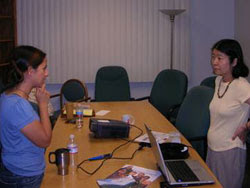 |
| Yuriko Saito talks with a student (in her everyday habitat) via |
Anyhow, after doing a little library sleuthing, I have found out that her work encompasses the relationship of aesthetic theory and environmental ethics, the moral dimensions of the Japanese aesthetic, and a critique on the primacy of the aesthetics of fine art acting as the main point of departure for applications in environmental ethics / aesthetics ... super fascinating. Here's her website at RISD for more about her.
I'm attaching a link to the article 'Everyday Aesthetics', and I have more of her essays in pdfs if you all are interested. If this doesn't work (you might have to be signed in to Cornell netid), I can email the file to anyone who wants it. Yuriko has been included in a bunch of anthologies on Environmental Ethics/Aesthetics, including the one Jim passed around today edited by Carlson and Berleant as well as having fairly recently published her own book (also called 'Everyday Aesthetics').
